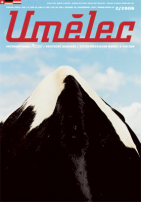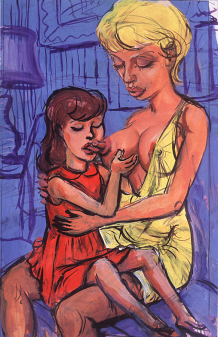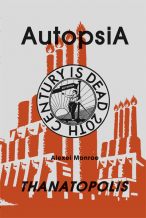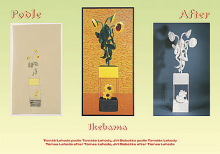| Umělec magazine 2006/2 >> Life in Counterculture | List of all editions. | ||||||||||||
|
|||||||||||||
Life in CountercultureUmělec magazine 2006/201.02.2006 Lenka Dolanová | interview | en cs |
|||||||||||||
|
Interview with Gene Youngblood
Gene Youngblood (1942) is an electronic media art critic and the author of Expanded Cinema (1970), one of the first publications dealing with video and computer-generated film. He has been elaborating its ideas—ranging from expanded conceptions of film and the arts to science, technology and cultural revolution—since 1967 in his weekly column, “Intermedia,” for the Los Angeles Free Press. Since that time he has lectured at more than 400 colleges and universities around the world. Currently, he is Professor of Critical Studies in the Department of Moving Image Arts at The College of Santa Fe. He is completing a book on Kit Galloway and Sherrie Rabinowitz, the founders of Electronic Café International (1984) and predecessors of real-time networked collaborative multimedia environments. Gene is also one of the pioneers of the Media Democracy movement in the US. The interview took place in Santa Fe on November 6, 2005, in the somewhat unreal atmosphere of a darkened local hotel saloon where Gene Youngblood took me from my hostel on Cerrillos Road. After removing his fedora hat and ordering margaritas, Youngblood seemed prepared for the forthcoming interview. I wanted to talk with him about history, but he preferred to talk about the (utopian) present. His style of speech gained enthusiasm, forcibility, with a conspiratorial tone emerging as his thoughts drew nearer to the present situation. He had the charm and conviction of a revolutionary; which he indeed seems to be. Your book, Expanded Cinema, published in 1970 has become legendary and is considered the first book discussing video as an art form. The term itself, “expanded cinema,” is still being used to refer to artworks that somehow attempt to expand the criteria of classical cinema. Yes, it has become generic. I am very happy about that. Where does this term come from? Did you invent it? There are some speculations about the origin, for example, Peter Weibel stated that it was he who had started using it first in 1967. You know, I honestly do not know where I got it. I don’t think I invented it. I have this vague memory that I read it in Jonas Mekas’ column in The Village Voice. I’m not sure. But I don’t think I invented it, no. So, why did you choose this term and what were its implications? There were two reasons. One was the idea that video would expand the possibilities of the moving image - in installations or immersive environments and in traditional single-screen movies. People were doing multiple screen projections and immersive environments, like the Hale’s Tours shows in the early 1900s, almost as soon as cinema began. Video makes it easier and expands the possibilities. In that sense video is an expansion of filmic practice. It’s a continuation of experimental films and documentaries. In your article from 1984 written for the Ars Electronica festival, A Medium Matures, you go as far as to say that there is nothing like video art, that video belongs entirely to the history of cinema. What I meant was that if you want to understand it, you have to put it in the historical context of the moving image. If you want a frame of reference, what is that going to be? It’s not the visual arts, not theater or literature. It can only be the moving image. There is a surface and on that surface there are images that move. So, from a phenomenological point of view, you don’t ask the ontological question: you don’t ask where the images come from. You just look at the screen and you ask, is this different from what I’ve seen before? My interest is not film or video but the art of the moving image regardless of the particular medium through which that art is practiced... But I still think that there is the gap between film scholars who usually do not write about video art and the people who deal with video. Theorizing about video is mostly related to the visual arts and the gallery space, not to the history of moving images. This is why I talk about the moving image. I don’t like the term video art. I don’t know what it means. It can only have a formalist reference - the graphic properties of the image. What can you do in video that’s different from film? Real time closed feedback loops and certain image processing techniques like compositing and morphing. Everything else you can do in film. You can do multiple projections, diaries, essays, documentaries, experimental narratives, and complex compositing and even morphing in animation. Video comes along and just does what film did and takes it further. Of course, formalist issues are very important. The electronic moving image can facilitate profound formal innovations, far beyond film. If film is the art of transition, video is the art of transformation. You kind of defend the approach that art has the power to expand the consciousness of the artist and the viewers. Do you still believe that art can or should have such a power, to transform the individual and the society? These days my interests are mostly political. In one sense there is no such a thing as political art. A work of art can represent a political issue but it can’t be political intrinsically. Only living situations are political. Only living context is political. We think Guernica is a political painting because we have the context for saying so. If somebody came from Africa and looked at that painting, they wouldn’t say it was political. But how can we connect it with the art? I read in an interview where you use the term “metadesigner,” for the person who should engender the context in which the artist can somehow enter and create content. I invented the term “metadesign,” or “metadesigner,” to talk about the practice of Kit Galloway and Sherrie Rabinowitz. I’m finishing 18 years of work on a book about their career, which I argue is the most visionary and important art career of the 20th century. I am proposing that the new avant-garde is about creating autonomous social worlds that people can live in. Art is central to that, but the art is not what’s avant-garde. What’s avant-garde is metadesign, the creation of context. Kit and Sherrie were metadesigners. They created networked contexts or platforms as environments for further cultural production. There was no Internet, so they had to create the context from scratch, from nothing. In their 1984 project called Electronic Café, they anticipated the Internet, websites and blogs. There are two definitions of avant-garde. The weak version says that avant-garde is just the latest thing, the latest technology. The strong version is articulated by Peter Burger in his book, The Theory of Avant-garde. He looks at the historical avant-gardes of the 1920s and 1930s and says that their goal was to destroy the social institution of autonomous art and merge art with life. They failed to do that, of course, because they didn’t have the means. They revolutionized art but not society. Metadesign offers a real possibility of social revolution. The new art of metadesign – of creating context as content - has an interesting consequence: it removes the idea of the avant-garde from art history, because it’s about creating a new world that people can live in, regardless of the art practices that manifest that world. Any kind of art that participates in constructing this world – no matter how retro the art may be - is participating in an avant-garde phenomenon. In fact, in more than 400 lectures around the world, across a twenty-year period, I never lectured about Expanded Cinema as such. It wasn’t political enough. I got highly politicized about the media even before Expanded Cinema was published. People would say: “Ah, you wrote Expanded Cinema, come and lecture!” And I would come and lecture about revolutionary media politics. From the very beginning of independent video in this country there was the political part of it which was more progressive than the arts part. Not surprising, it always is. Was Guerilla TV trying to transform commercial television? Yes, but most others were trying to create alternative networks. And they came from a long history of political critiques of mass media which started as soon as there was a mass medium. When portapaks and public access cable TV became available, some people wanted to use them for formalist experiments, others wanted to create alternative social worlds, alternative cultures to live in. That was always more important to me, and today it’s all I think about. In this country today it is possible to live 24 hours a day, 7 days a week, in an alternative media counterculture. I am talking about the combination of the Internet and two satellite TV channels – Free Speech TV and Link TV. I live on a daily basis in a world that is opposite to the one my neighbor lives in, the world constructed by corporate media, which I call The Broadcast. The possibility to do this is unprecedented in human history. It is then the new utopian community? Hmmm, utopian? It’s just real! It’s just there. Utopian means something that doesn’t exist. But I live in this alternative world every day. When you live in a culture, you are being socialized all the time. Social control is not possible without controlling the culture in which the population constructs itself. That’s why societies do their best to make it impossible for people to live in alternative social worlds that the society cannot control. Well, it’s now possible to secede from The Broadcast and live 24 hours a day in a media counterculture. You can’t overemphasize the importance of this explosive situation. But what does it have to do with art? Plenty. Because it is art through which we make representations of possible realities. Until now, there has never been an autonomous social world that could legitimate and empower models of other ways of living our lives. In terms of what’s called “New Media Arts” – the interactive, immersive, multimedia artistic practices made possible by digital technology and the Internet – my interest is how they can participate in this sociopolitical revolution. This might be similar to what Peter Weibel stated at his Ars Electronica lecture last year, that there is another expansion of art happening now, and it’s the expansion of its competence. So do you think that art can now receive greater competence, that it can enter the spheres which were previously reserved, for example, for sociology, and other disciplines? Oh, yes, absolutely. But only because of this meta-context, this world that now exists, and which art cannot create; not art, but technology created the possibility. But now art can enter that and expand its sphere of competence or relevance. Art can now expand into a sociopolitical realm that was inaccessible before. People in this country live in a mental prison. I don’t think the rest of the world understands how blinded Americans are, because we live in the perceptual imperialism imposed by The Broadcast, by corporate media. It is incredibly important to have an alternative to that. The corporate takeover of American culture is the most dangerous thing happening today. How do you think it will evolve in the future? I don’t predict the future, I prescribe what ought to happen. And what ought to happen is empowerment of the alternative media worlds.. Everybody needs to jump on this opportunity. Every artist, anybody, whatever they do, whatever they can do, should jump on this and build it into something. It is not utopia. What is utopia, anyway? What does it mean? The idea of a different, alternative world which would be better than the one we are living in. Yes, and it is there. I live in it every day. For most people the notion of utopia caries a negative connotation. Utopia is some kind of fantasy or something in the future, but this particular utopia is not fantasy; it’s a living reality that exists right now. I say that if a discourse is not utopian, it is not radical enough. I don’t believe that politics is more important than art; I think they are equal, but I can’t talk about one without the other. I want to empower politics in order to empower art, and for the first time it’s actually possible because now you are talking about the world; you are not in the gallery any more. Later, in a Mexican fish restaurant, Gene Youngblood met his longstanding friends, video art pioneers Steina and Woody Vasulka, and they were discussing American politics; the difference between common television broadcast and what you can see on independent television; the gap between the large scope of manipulation and the large extent of people are aware of it, which is so apparent for the first time in history; and paradoxes of American life as well as those of private lives. Gene Youngblood was talking about the current dark times of his country and said that he is trying to find a way in which to present his vision of alternative Internet based communities to ordinary people, not talking just to scholars (as other scholars do); because only then the revolution will be possible. He admitted he moved to Santa Fe from California also because the Vasulkas had moved here a few years before, but sadly they announced that they are now leaving him to either return to Brno, Woody´s hometown, or to Iceland, where Steina comes from – the Vasulkas probably do not share his visions thus far and it seems like they also have their own ideas of alternative worlds. You can find information about Free Speech TV and Link TV at www.freespeech.org and www.worldlinktv.org. About Electronic Cafe International you can read on www.ecafe.com.
01.02.2006
Recommended articles
|
|||||||||||||
|
04.02.2020 10:17
Letošní 50. ročník Art Basel přilákal celkem 93 000 návštěvníků a sběratelů z 80 zemí světa. 290 prémiových galerií představilo umělecká díla od počátku 20. století až po současnost. Hlavní sektor přehlídky, tradičně v prvním patře výstavního prostoru, představil 232 předních galerií z celého světa nabízející umění nejvyšší kvality. Veletrh ukázal vzestupný trend prodeje prostřednictvím galerií jak soukromým sbírkám, tak i institucím. Kromě hlavního veletrhu stály za návštěvu i ty přidružené: Volta, Liste a Photo Basel, k tomu doprovodné programy a výstavy v místních institucích, které kvalitou daleko přesahují hranice města tj. Kunsthalle Basel, Kunstmuseum, Tinguely muzeum nebo Fondation Beyeler.
|









































 New book by I.M.Jirous in English at our online bookshop.
New book by I.M.Jirous in English at our online bookshop.
Comments
There are currently no comments.Add new comment